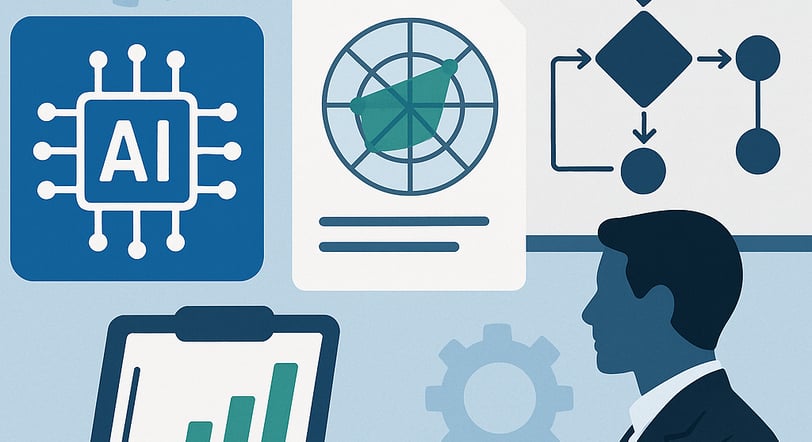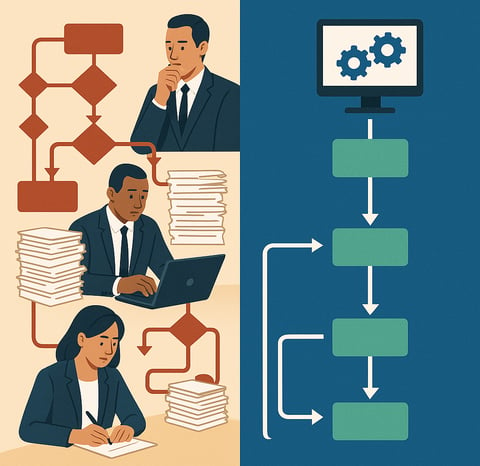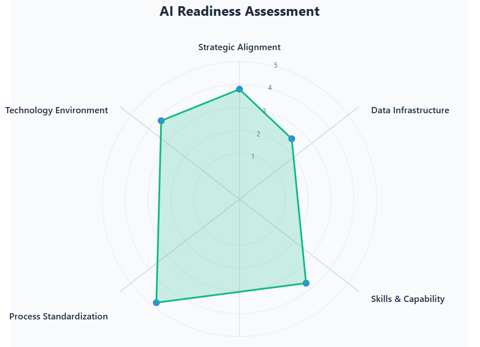AI Readiness Assessment: Is Your SME Ready for Intelligent Automation?
Embarking on an AI implementation journey requires more than just technological investment. For SMEs to truly benefit from intelligent automation, they need a holistic readiness assessment across five key organizational dimensions. This checklist will help you evaluate your company's AI maturity and identify critical areas for development before making significant investments.
SMEGUIDEPROCESS AUTOMATION
Dávid Pálfalvi
5/20/20256 min read


Why AI Readiness Matters for SMEs in 2025
As AI adoption continues to accelerate, the gap between digital leaders and laggards grows wider. With 75% of businesses now using AI-powered tools—up dramatically from just 22% in 2023—the technology is no longer optional for competitive businesses. Yet despite this surge, only 13% of companies globally are fully prepared to leverage AI effectively. For Hungarian and Eastern European SMEs, this presents both a challenge and an opportunity. While larger corporations may have more resources, smaller businesses can often implement AI solutions more nimbly—if they're properly prepared. An AI readiness assessment isn't just another technology checklist; it's a strategic framework that ensures your investment delivers genuine business value.
The 5 Critical Dimensions of AI Organizational Readiness
To systematically evaluate your organization's AI maturity, we've identified five core dimensions that determine readiness for intelligent automation. Each dimension requires honest assessment and strategic planning to build a solid foundation for AI implementation.
1. Strategic Alignment & Leadership Commitment
Before any technology implementation, your organization needs clear alignment between AI initiatives and broader business objectives. This dimension evaluates whether leadership understands and supports AI transformation.
Assessment Questions:
Has your leadership team articulated how AI aligns with company strategy?
Is there a designated executive sponsor for AI initiatives?
Has budget been allocated specifically for AI projects and related training?
Do strategic planning documents explicitly mention automation and AI?
Red Flags:
AI initiatives proposed without clear business problems to solve
Executives who view AI as "just an IT project"
Lack of willingness to invest in necessary infrastructure
According to recent market analysis, organizations with documented AI strategies linked to business outcomes are 2.3 times more likely to report successful implementations. Yet only 34% of European SMEs have such documentation in place.


2. Data Infrastructure & Governance
AI systems are only as good as the data they consume. This dimension evaluates whether your organization has sufficient quality data and the infrastructure to leverage it effectively.
Assessment Questions:
Do you have data collection systems that capture relevant business information?
Is your data consistently formatted, accurate, and accessible?
Do you have clear data governance policies and ownership guidelines?
Can your current systems integrate with AI solutions via APIs?
Red Flags:
Data scattered across disconnected legacy systems
Poor data quality with significant missing values or inconsistencies
Lack of standardized data collection procedures
Undefined roles for data management
A concerning reality for many Hungarian SMEs is that while 72% believe they have valuable data, only 28% have the infrastructure to easily access and utilize it for AI applications. This disconnect creates a significant barrier to successful implementation.
3. Skills & Organizational Capability
Even with leadership buy-in and solid data, your organization needs people who can implement and work with AI systems. This dimension assesses your talent readiness.
Assessment Questions:
Do you have technical staff with AI/ML knowledge or development capabilities?
Are business users digitally literate and adaptable to new technologies?
Is there capacity for staff to participate in implementation projects?
Do you have access to external expertise if needed?
Red Flags:
General resistance to technological change
Lack of basic digital literacy among key staff
No budget allocated for upskilling employees
IT team already overwhelmed with existing maintenance
The European skills gap is particularly pronounced in AI implementation. Recent surveys show that 67% of SMEs cite lack of in-house expertise as their primary barrier to AI adoption. However, companies that invest just 5% of their AI budget in training see adoption rates improve by 35%.
4. Process Standardization & Optimization
Automating broken processes only creates faster problems. This dimension evaluates whether your core business processes are sufficiently defined and optimized for AI enhancement.
Assessment Questions:
Are key business processes clearly documented and standardized?
Have you identified high-value, repetitive processes suitable for automation?
Do current workflows have clear inputs, outputs, and decision points?
Have you measured process performance to establish baselines?
Red Flags:
Significant process variations between teams or individuals
Heavy reliance on tribal knowledge rather than documentation
Processes with many exceptions or manual interventions
No established KPIs for current process performance


5. Technology Environment & Architecture
Your existing technology stack significantly impacts AI implementation success. This dimension assesses your current infrastructure's readiness to support AI solutions.
Assessment Questions:
Is your current IT infrastructure capable of supporting AI applications?
Do you have systems that can be connected through APIs?
Are your security and compliance measures adequate for AI implementation?
Can your infrastructure scale to accommodate growing data and processing needs?
Red Flags:
Outdated legacy systems without API capabilities
Insufficient computing resources or cloud infrastructure
Rigid architecture that resists integration
Security protocols inadequate for advanced data processing
Need help implementing these strategies in your business? Book a quick consultation with our experts to discuss your specific needs.
How to Conduct Your AI Readiness Assessment
Evaluating your organization across these five dimensions requires a systematic approach to gather accurate insights and create an actionable roadmap for improvement.
Step 1: Form a Cross-Functional Assessment Team
AI readiness isn't solely an IT matter. Assemble representatives from: - Executive leadership - Operations and key business units - IT and data management - Human resources - Finance This diverse team ensures all perspectives are considered and builds broader organizational buy-in.
Step 2: Gather Data Across All Dimensions
For each dimension, collect evidence through: - Interviews with key stakeholders - Review of existing documentation and systems - Analysis of current process performance - Skills inventory of current staff - Technical assessment of infrastructure Be thorough but efficient—most SMEs can complete initial data gathering in 2-3 weeks.
Step 3: Score Your Current State
Using a simple 1-5 scale for each dimension:
Initial: No formal approach or significant gaps
Developing: Basic capabilities with significant improvement needed
Defined: Structured approach with moderate capabilities
Advanced: Well-developed capabilities with minor gaps
Optimized: Comprehensive, mature capabilities
This scoring helps prioritize areas for improvement and track progress over time.


Step 4: Develop a Prioritized Roadmap
Based on your assessment: - Focus first on dimensions scoring below 3 - Identify quick wins that can build momentum - Address interdependencies (e.g., data governance before advanced analytics) - Create a 3-6 month action plan with specific initiatives For Hungarian SMEs, our experience shows that data infrastructure and skills development typically require the most attention initially.
Case Study: Hungarian Manufacturing SME Transformation
A medium-sized manufacturing company based in Győr illustrates how a structured AI readiness assessment can lead to successful implementation.
Initial Challenge: The company wanted to implement predictive maintenance using machine learning but struggled with several failed attempts. Their initial focus had been solely on finding the right AI technology.
Assessment Findings:
Strategic Alignment: Score 4/5 – Strong leadership support with clear objectives
Data Infrastructure: Score 2/5 – Data siloed in multiple systems, poor quality
Skills: Score 1/5 – No data science capability, limited digital literacy
Process Standardization: Score 3/5 – Documented but inconsistently followed
Technology: Score 3/5 – Adequate infrastructure but integration challenges
Transformation Approach: Rather than immediately pursuing AI implementation, the company first invested in a centralized data platform to consolidate machine performance data. Secondly, they established data quality standards and governance procedures. As a third step, partnered with a technical university for staff training and knowledge transfer. Lastly they standardized maintenance processes across all production lines
Results After 9 Months:
28% reduction in unplanned downtime
AI readiness scores improved across all dimensions
Successful pilot implementation of predictive maintenance on critical equipment
Staff now proactively identifying new AI use cases
This case demonstrates that addressing foundational readiness issues first leads to more sustainable AI implementation success.
Common Pitfalls in SME AI Readiness
Our experience with Hungarian and Eastern European SMEs reveals several recurring challenges:
Technology-First Thinking: Focusing on AI capabilities rather than business problems to solve
Underestimating Data Requirements: Failing to address data quality and accessibility before implementation
Skills Myopia: Considering only technical skills while ignoring change management capabilities
Scope Ambition: Attempting complex AI projects before establishing fundamentals
Integration Oversight: Not adequately considering how AI solutions will integrate with existing systems
Avoiding these pitfalls requires honest assessment and sometimes slowing down to build proper foundations before accelerating implementation.
Key Takeaways: Your AI Readiness Action Plan
1. Be honest about your starting point – An accurate assessment of current capabilities is more valuable than an optimistic one.
2. Prioritize your gaps – Not all dimensions need to be at maximum maturity before beginning. Focus on the most critical barriers first.
3. Start small, learn fast – Consider pilot projects that can build capabilities while delivering value.
4. Build cross-functional ownership – AI readiness extends beyond IT to all business functions.
5. Reassess regularly – AI readiness is a journey, not a destination.
Plan to reassess every 6-12 months. The path to AI maturity is not about perfection in every dimension but about having sufficient capability to begin capturing value while continuously improving. Ready to transform your business operations? Fill out our quick contact form to get started, or schedule a 15-minute consultation directly with our implementation specialists.
Innovate with Intellect.
Revolutionize workflows with cutting-edge AI solutions.
About Us
2024-2025 Innovectus - All rights reserved.
